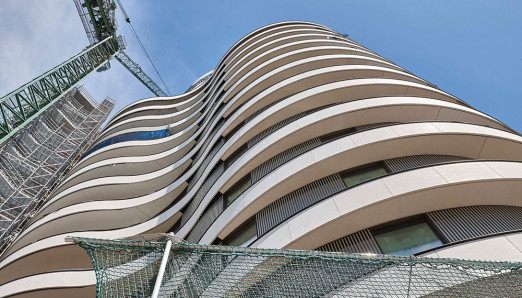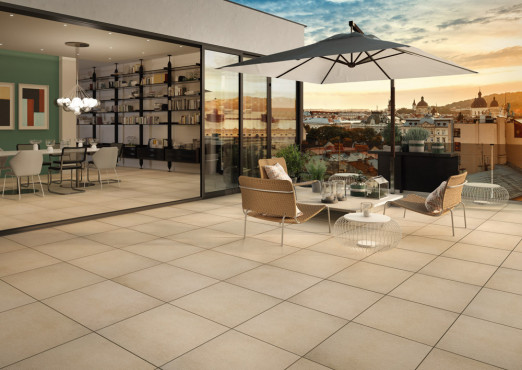Roofs are one of the first lines of defence when it comes to protecting buildings from the elements. As such, they are highly susceptible to wear and tear, however well they may have been designed and installed. Inevitably, roofs may at some stage need to be repaired and/or will reach the end of their design life.
Liquid waterproofing systems provide a highly effective method of extending a flat roof’s life – in excess of 25 years depending on the product used – saving money on replacement costs and improving the quality of the existing covering. Chris Page, Flat Roofing Product Manager at SIG Design & Technology, discusses when architects should use liquid waterproofing, what products are available, and how should the design, specification and installation processes be approached?
Is liquid waterproofing suitable for all types of roof refurbishment?
Cold-applied liquid waterproofing is suitable for all types of flat roof refurbishment, subject to the condition of the existing covering and substrate. Remedial works may need to be carried out before the liquid waterproofing is applied, such as installing recovery boards to separate the old and new roof systems. Cold-applied liquid waterproofing is not suitable for tile-clad pitched roofs, although it can be used on some profiled metal sheets.
What are the benefits of using liquid waterproofing on refurbishment projects?
There are several key advantages. First, the existing roof covering can be left in place, reducing the risk of water ingress and avoiding the need to consign unrecyclable waste, such as pvc membranes, to landfill. Second, liquid waterproofing can be installed quickly with minimal risk to the building’s occupants. It can also accommodate protrusions, such as rooflights, pipe outlets, and plant with ease. Third, the flexibility of liquid waterproofing means it is ideal for zoned multi-purpose roofs, featuring recreational spaces, sedum coverings, solar panels, and air conditioning units.
Fourthly, liquids are self-terminating and therefore don’t require the mechanical restraint of a single ply membrane that can be difficult on roofs where there are many changes of direction, or where the lapping of bituminous felt would have to be carefully considered. This makes them ideal for complex roofs. Last but not least, liquid waterproofing can provide guarantees that are comparable with bitumen roofs and single ply membranes.
What types of product are available and how do specifiers choose between them?
SIG Design & Technology provides a wide range of cold-applied liquid waterproofing systems, covering different price points, performance criteria and guarantees. Among the most popular products are Hydrostop AH25+ and AH15+, Vulkem Quick System, and SIGnature PU. The latter is a polyurethane-based single-coat system that is designed to provide excellent elasticity and tensile strength. It is available with 10- and 20-year guarantee options.
Vulkem Quick’s hardwearing and fast-curing characteristics mean that it is particularly suited to high-traffic areas, such as communal walkways, terraces, balconies, and pedestrian bridges. The aesthetically pleasing, UV-resistant polyurethane-modified methyl methacrylate (PMMA) system can be applied during the winter at very low temperatures and is guaranteed for 20 years.
Hydrostop AH25+ is an innovative, one-component system which is an evolution of SIG’s AH-25 system and can be guaranteed for up to 25 years. It is solvent, fume and isocyanate-free, making it ideal for ‘occupied’ refurbishment projects, such as hospitals, offices and residential buildings. Hydrostop AH+ is designed with ease-of-use and flexibility in mind. The non-solvent-based system can be installed in successive coats without the need for primers or abrasion. Furthermore, it can now also be applied to tissue-faced insulation boards. Other benefits include fast curing, price flexibility (due to warranty options of 15 and 25 years), as well as green roof compatibility.
Ultimately, liquid waterproofing specification will depend on a range of factors, including cost. The length of warranty required may depend on the overall design life of the building. There is no point in choosing a product with a 25-year warranty if the existing structure is due to be demolished in the next 10 to 15 years. Specifiers must also ensure product compatibility with existing roof elements, such as ‘zero’ falls, sedum covering, or inverted build-ups. Installation should also be carefully considered, with non-solvent-based products used on occupied buildings.
Alongside product selection, architects should pay careful attention to the condition of the existing roof. Adequate surface preparation is critical to the long-term performance of all liquid waterproofing systems. Large undulations, excessive moisture in the substrate, loose and deleterious surface matter, as well as dirt and dust, must be removed prior to installation of the new roof covering. Specifiers may therefore need to consider a range of surfaces treatments, including scarifying, de-watering, introducing moisture vents and laying recovery boards.
With regards to installation, liquid waterproofing should always be applied by a fully trained contractor. The SIG Design & Technology Accredited Contractor (DATAC) scheme provides assurance that SIG liquid waterproofing products, such as SIGnature PU, Vulkem Quick and Hydrostop AH+, are properly installed. Additional quality control is provided by SIG Area Field Technicians who provide onsite support and check installations conform to product and regulatory requirements.






